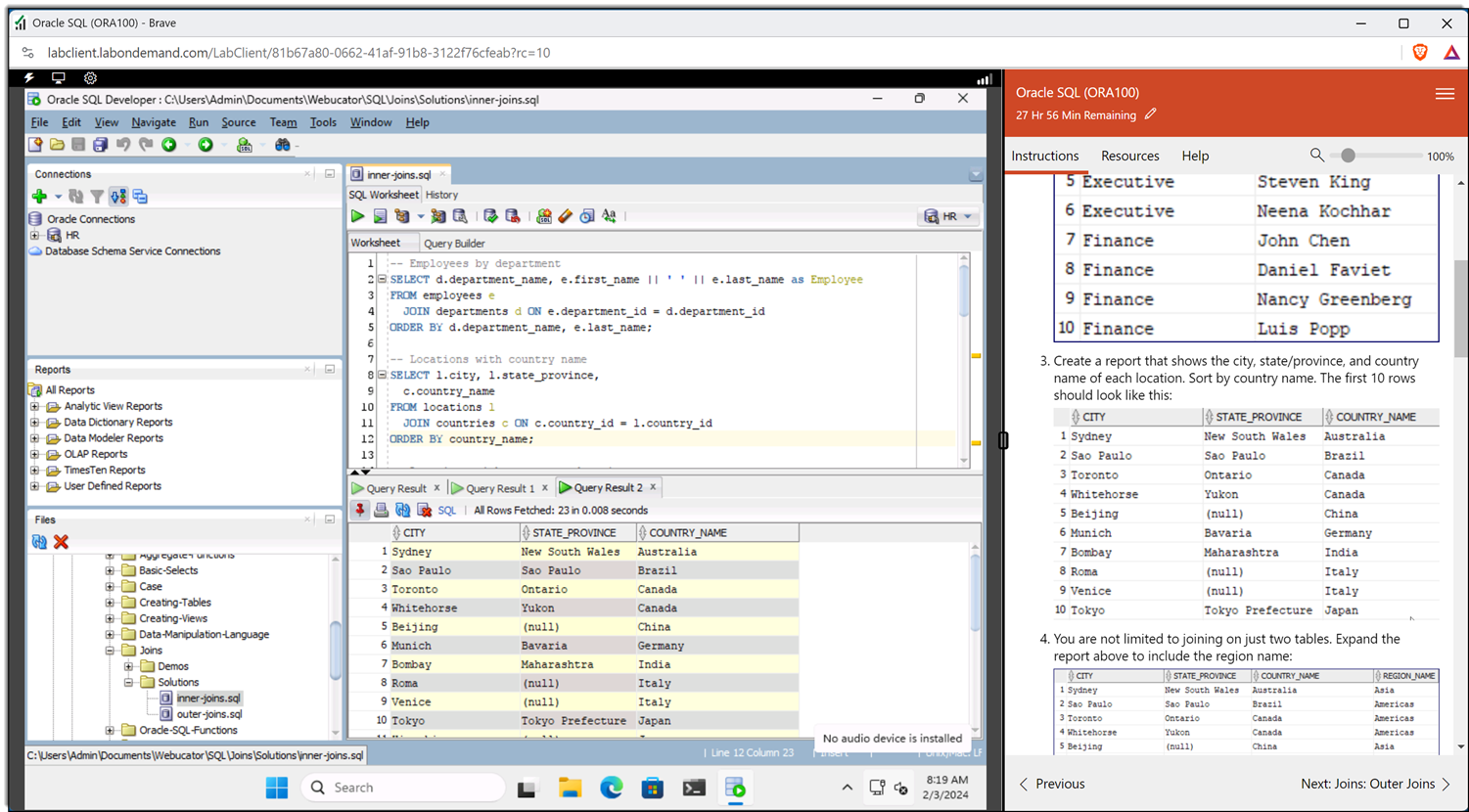
Oracle SQL Courseware (ORA100)
This Oracle SQL course is designed for beginners who want to learn the fundamentals of SQL using Oracle Database. The course covers topics such as relational database basics, creating tables, basic selects, Oracle SQL functions, aggregate functions, joins, subqueries, set operators, conditional processing with CASE, Data Manipulation Language (DML), and creating views. Through practical exercises and real-world examples, students will gain a strong foundation in SQL and learn how to create, manipulate, and retrieve data from Oracle databases efficiently and effectively.
Benefits
- Foundational Knowledge: The course provides a comprehensive introduction to Oracle SQL, ensuring students have a solid understanding of SQL fundamentals and Oracle database management.
- Hands-on Learning: Practical exercises and real-world examples help students develop their skills and confidence in working with Oracle SQL.
- Efficient Data Management: Students will learn how to create, manipulate, and retrieve data from Oracle databases efficiently and effectively, improving their productivity and problem-solving abilities.
- Scalable Learning: The course serves as a strong foundation for learning Oracle PL/SQL or for becoming a DBA.
PowerPoint Presentation
This course includes a PowerPoint presentation that maps to the manual and to the labs:
Full Lab Environment Add-On
Enhance and simplify your classes by providing an unparalleled learning platform that requires no setup. Your trainers and students can dive straight into a fully-prepared lab environment with just a click. This seamless integration means no time wasted on installations or configurations, allowing trainers and students to focus solely on the task at hand. The lab comes pre-loaded with all the necessary tools and resources, ensuring a smooth, hassle-free learning experience.

Outline
- Relational Database Basics
- Brief History of SQL
- Relational Databases
- Popular Databases
- Schemas and Users
- Creating Tables
- Data Types
- Creating Tables
- Creating Tables (Exercise)
- Adding Constraints
- Altering the departments_copy Table (Exercise)
- UNIQUE Constraints
- Adding and Dropping Columns
- Dropping Tables
- Basic Selects
- Comments
- Whitespace and Semi-colons
- Case Sensitivity
- SELECTing All Columns in All Rows
- Exploring the Tables (Exercise)
- SELECTing Specific Columns
- SELECTing Specific Columns (Exercise)
- Sorting Records
- Sorting Results (Exercise)
- The WHERE Clause and Logical Operator Symbols
- Using the WHERE Clause to Check for Equality or Inequality (Exercise)
- Checking for Greater Than or Less Than
- Using the WHERE Clause to Check for Greater or Less Than (Exercise)
- Checking for Null and Not Null
- Checking for NULL (Exercise)
- WHERE and ORDER BY
- Using WHERE and ORDER BY Together (Exercise)
- Checking Multiple Conditions with Boolean Operators
- Writing SELECTs with Multiple Conditions (Exercise)
- The WHERE Clause and Logical Operator Keywords
- More SELECTs with WHERE (Exercise)
- Limiting Rows
- Working with FETCH (Exercise)
- Oracle SQL Functions
- The DUAL Table and Column Aliases
- Calculated Fields
- Calculating Commissions (Exercise)
- ROW_NUMBER()
- Numeric Functions
- Using MOD() (Exercise)
- Character Functions Returning Character Values
- Concatenation (Exercise)
- More Character Functions Returning Character Values
- Character Functions Returning Number Values
- Datetime Functions
- Dates (Exercise)
- SQL*Plus column Command
- NULL-Related Functions
- NULL Functions (Exercise)
- Other Functions
- Aggregate Functions
- Introduction to Aggregate Functions
- Working with Aggregate Functions (Exercise)
- Grouping Data
- Grouping Results (Exercise)
- Selecting Distinct Records
- ROLLUP() and CUBE()
- Joins
- Inner Joins
- Inner Joins (Exercise)
- Outer Joins
- Outer Joins (Exercise)
- Subqueries
- Subquery Basics
- Subqueries (Exercise)
- Subqueries in the SELECT Clause
- Subqueries in SELECTs (Exercise)
- Set Operators
- Set Operators
- UNION
- UNION ALL
- INTERSECT
- MINUS
- Working with Set Operators (Exercise)
- Set Operators and Aliases
- Conditional Processing with CASE
- Selected Case
- Searched Case
- Working with CASE (Exercise)
- Data Manipulation Language
- Transactions and Sessions
- INSERT
- Inserting Records (Exercise)
- UPDATE
- DELETE
- Updating and Deleting Records (Exercise)
- Updating and Deleting Multiple Records
- Creating Views
- Creating Views
- Benefits of Views
- Creating a View (Exercise)
- Inline Views
Required Prerequisites
None
License
Length: 4
days | $160.00 per copy
Labs: Add-on available | $56.07 per lab
View Lab Details
What is Included?
- Student Manual
- Student Class Files
- PowerPoint Presentation
- Labs (optional add-on)
Courseware Tracks
This course is included in the following tracks: